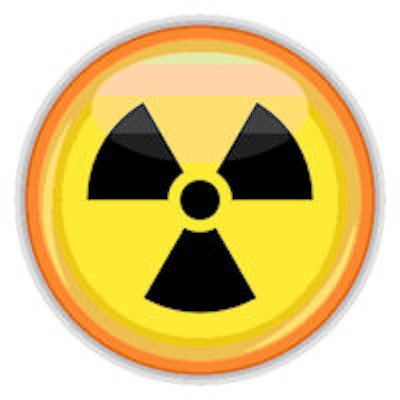
Patient-specific, weight-based imaging protocols for FDG-PET/CT can significantly reduce CT radiation dose without compromising diagnostic image quality, according to a study from American University of Beirut in Lebanon.
Researchers reduced radiation dose by 43% and achieved double-digit decreases in lifetime attributable risk for cancer by adjusting CT tube current (mAs) modulation based on factors such as a patient's height, weight, and body mass index (BMI).
"The fact of the matter is we have an obligation under the ALARA [as low as reasonably achievable] principle to try to reduce radiation dose to as low as reasonably treatable and not to affect the outcomes for our radiologists," said lead study author Charbel Saade, PhD, in his presentation at RSNA 2015.
Cutting radiation exposure
The goal to reduce radiation exposure is especially critical for younger patients with lingering conditions who require periodic imaging scans, Saade said.
 Charbel Saade, PhD, from American University of Beirut in Lebanon.
Charbel Saade, PhD, from American University of Beirut in Lebanon."Patients under the age of 20 are coming for PET/CT," Saade said. "We have a role in trying to reduce the amount of radiation dose as much as possible. No one knows what the survival [rate] is. We have statistics, studies, and new techniques on the rise, but currently this is the best way, in my opinion and the opinion of the institution I come from, to do that for our patients, whether they are cancerous or noncancerous."
Saade cited several previous studies on how much radiation dose a patient can be exposed to through standard CT imaging protocols.
"If we look at current research, there are a lot of variations between total body PET/CT dose values that come from just CT," he said. "On average, we are looking at between 2.5 mSv and 33 mSv. This highlighted for us the need to find a way to reduce this for patient-specific delivery of radiation dose."
This prospective randomized study compared various levels of potential CT radiation exposure with a hybrid multidetector CT and PET scanner (Gemini TF PET/CT, Philips Healthcare).
When the PET/CT system was first installed, the facility initially used a standard CT protocol of 0.5-sec rotation time, 120 kVp, 120 mAs, pitch of 0.8 mm, collimation of 3 mm, and detector range of 10 mm. However, the practice soon began to explore weight-specific protocols.
"We knew that patients under 60 kilos (132 lb) show a different body composition and density compared to patients between 60 and 80 kilos (176 lb), 80 and 100 kilos (220 lb), and more than 100 kilos," Saade explained.
The researchers sought to make the imaging protocols for each weight category as simple as possible and maintained the same parameters, except for mAs modulation, which was adjusted to 35, 50, 65, and 100 in the four weight categories, respectively, and counteracted mAs modulation changes by increasing kVp from 120 to 140.
Saade and colleagues divided patients into two groups. The standard FDG-PET/CT imaging protocol included 261 males and 277 females with an average height of 5 feet 5 inches ± 2 feet 0.6 inches (1.65 m ± 0.6 m) and average weight of 168 lb ± 41.6 lb (76.4 kg ± 19 kg). Mean body mass index was 34.3 ± 91.4.
The second group was imaged with the weight-based protocols and included 239 males and 250 females with an average height of 5 feet 3 inches ± 6.6 inches (1.61 m ± 0.2 m) and average weight of 166.6 lb ± 47.8 lb (75.6 kg ± 21.7 kg). Mean body mass index was 35.2 ± 57.
Adjusting protocols
As part of the weight-based protocol, researchers also considered both body surface area and lean body weight, "because there is a difference between males and females in lean body weight mass," Saade said. "And, of course, the taller your patient is, the more radiation dose you are going to give."
The study also measured the anteroposterior (AP) diameter of the patients' chests, "because with the principles of mAs modulation, you are looking at AP and transverse diameters [of the chest], which will help predict how much radiation dose a patient should receive," he added.
From there, researchers determined the CT dose index (CTDI) volume, which measures the radiation dose output of a CT scanner to make sure safe levels are maintained for patients. In addition, dose-length product (DLP) values also were calculated, which pertain to the amount of radiation a patient receives.
And, it is in the DLP values and the CTDI volume where the researchers discovered the benefits of the weight-based protocols.
The DLP value for the standard PET/CT protocol was 1016 ± 381.7, compared with a DLP value of 673.8 ± 278.9 for the weight-based imaging method (p < 0.0001). The CTDI volume for the standard PET/CT technique was 7.3 ± 2, compared with a CTDI volume of 4.2 ± 1.3 using the weight-based imaging protocol (p < 0.0001).
"When we looked at our radiation dose values, we found statistical significance between the DLP and CTDI volume," Saade said. "And we found a 45% reduction in radiation dose using this [weight-based] technique."
Lifetime attributable risk
Also of importance are lifetime attributable risk values, especially for younger patients who risk developing cancer as they undergo multiple imaging exams that involve radiation.
"The older you get, the less chance you will have cancer," Saade said. "The younger you are, the more change you have because of your developing organs."
Thus, researchers divided patients into different age groups, beginning at younger than 1 year to 80 years. The groups were divided by intervals of five years up to 20 years of age and 10-year intervals from 20 to 80 years.
Comparing the two imaging techniques across all age categories, the researchers found that the decrease in radiation exposure with the weight-based CT protocol lowered lifetime attributable risk by 69% among female patients and 21% among male patients.
To assess image quality, researchers took contrast-to-noise measurements of the aorta to determine the contrast-to-noise ratio. The standard imaging protocol had a contrast-to-noise ratio of 0.35 ± 2.8, compared with a ratio of 0.7 ± 3.7 (p = 0.21) for the weight-based technique.
"While there was a significant reduction in radiation dose, we found no correlation at all or statistical significance in terms of quantitative radiation dose reduction using image quality tests," Saade concluded. "By using this technique quantitatively, we found strong significance we could reduce radiation dose and maintain our visual qualitative approach."




















